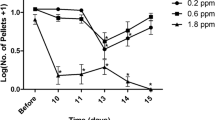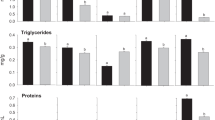Abstract
Freshwater crayfish Cherax quadricarinatus have a high commercial value and are cultured in farms where they are potentially exposed to pesticides. Therefore, we examined the sublethal effects of a 50-day exposure to glyphosate acid and polyoxyethylenamine (POEA), both alone and in a 3:1 mixture, on the growth and energetic reserves in muscle, hepatopancreas and hemolymph of growing juvenile crayfish. Exposure to two different glyphosate and POEA mixtures caused lower somatic growth and decreased muscle protein levels. These effects, caused by both compounds interacting in the mixture, could also be synergistic because they were expressed even at the lowest concentration. The decrease in protein levels could be related to the greater use of other energy reserves. This hypothesis is supported by the decrease in muscle glycogen stores due to glyphosate exposure and the decrease in lipid reserves associated with exposure to POEA.






Similar content being viewed by others
References
American Public Health Association, American Water Works Association, Water Pollution Control Federation (1995) Standard methods for the examination of water and wastewater, 19th edn. American Public Health Association, Washington
Bidwell J, Gorrie J (1995) Acute toxicity of an herbicide to selected frog species. Technical Series 79. Department of Environmental Protection, Perth
Carlisle SM, Trevors JT (1988) Glyphosate in the environment. Water Air Soil Pollut 39:409–420
Chang ES, O’Connor JD (1983) Metabolism and transport of carbohydrates and lipids. In: Mantel LH (ed) The biology of crustaceans, vol 5. Academic, New York, p 263
Coglianese M, Neff JM (1982) Biochemical responses of the blue crab, Callinectes sapidus to pentachlorophenol. In: Vernberg WB, Calabrese A, Thurberg FP, Vernberg EJ (eds) Physiological mechanisms of marine pollutant toxicity. Academic, New York, p 127
Folch J, Lees M, Stanley GHS (1957) A simple method for isolation and purification of total lipids from animal tissues. J Biol Chem 226:497–509
Fring CS, Dunn RT (1970) A colorimetric method for determination of total serum lipids based on the sulfophosphovanilina reaction. Am J Clin Pathol 53:89–91
Frontera JL (2010) Toxic effects of glyphosate and its commercial formulation on early juveniles of the freshwater crayfish Cherax quadricarinatus. Doctoral thesis, University of Buenos Aires, Buenos Aires
Giesy JP, Dobson S, Solomon KR (2000) Ecotoxicological risk assessment for Roundup herbicide. Rev Environ Contam Toxicol 167:35–120
Glusczak L, Miron SD, Crestani M, Fonseca BM, Pedron AF, Duarte FM et al (2006) Effect of glyphosate herbicide on acetylcholinesterase activity, metabolic and hematological parameters in piava (Leporinus obtusidens). Ecotoxicol Environ Saf 65:237–241
Glusczak L, Miron DS, Moraes BS, Simões RR, Schetinger MRC, Morsch VM et al (2007) Acute effects of glyphosate herbicide on metabolic and enzymatic parameters of silver catfish (Rhamdia quelen). Comp Biochem Physiol C 146:519–524
Graney RL, Giesy JP (1986) Effects of long-term exposure to pentachlorophenol on the free amino acid pool and energy reserves of the freshwater amphipod Gammarus pseudolimnaeus Bousfield (Crustacea, Amphipod). Ecotoxicol Environ Saf 12:233–251
Herreid CF, Full RJ (1988) Energetics and locomotion. In: Burggren WW, McMahon BR (eds) Biology of the land crabs. Cambridge University Press, Cambridge, p 333
Howe CM, Berrill M, Pauli BD, Helbing CC, Werry K, Veldhoen N (2004) Toxicity of glyphosate-based pesticides to four North American frog species. Environ Toxicol Chem 23:1928–1938
Jiraungkoorskul W, Upatham ES, Kruatrachue M, Sahaphong S, Vichasri-Grams S, Pokethitiyook P (2002) Histopathological effects of Roundup, a glyphosate herbicide, on Nile tilapia (Oreochromis niloticus). Sci Asia 28:121–127
Jiraungkoorskul W, Upatham ES, Kruatrachue M, Sahaphong S, Vichasri-Grams S, Pokethitiyook P (2003) Biochemical and histopathological effects of glyphosate herbicide on Nile tilapia (Oreochromis niloticus). Environ Toxicol 18:260–267
Jones CM (1997) The biology and aquaculture potential of the tropical freshwater crayfish Cherax quadricarinatus. Department of Primary Industries, Brisbane
Lindgren A, Sjostrom M, Wold S (1996) QSAR modeling of the toxicity of some technical nonionic surfactants towards fairy shrimps. Quant Struct Act Relatsh 15:208–218
Lowry OH, Rosenbrough NJ, Randall RJ (1951) Protein measurements with the Folin phenol reagent. J Biol Chem 183:265–275
Lydon J, Duke SO (1989) Pesticide effects on secondary metabolism of greater plants. Pestic Sci 25:361–373
Mann RM, Bidwell JR (1999) The toxicity of glyphosate and several glyphosate formulations to four species of southwestern Australian frogs. Arch Environ Contam Toxicol 36:193–199
Mayer FL, Versteeg DJ, McKee MJ, Folmar LC (1992) Physiological and nonspecific biomarkers. In: Huggett RJ, Kimerle RA, Mehrle PM, Bergman HL (eds) Biomarkers, biochemical, physiological, and histological markers of anthropogenic stress. Lewis, Boca Raton, p 5
National Pesticide Use Database (2004) Pesticide use data. http://www.croplifefoundation.org/cpri_pestuse.htm. Accessed 19 Jan 2007
Nelson H (1991) Scheduling of reproduction in relation to molting and growth in malacostracan crustaceans. In: Wenner A, Kuris A (eds) Crustacean issue 7. Crustacean egg production. Balkema, Rotterdam, p 77
Palafox J, Figueroa JL, Romero X (1999) Análisis del cultivo comercial de la langosta de agua dulce (Cherax quadricarinatus) y su posible impacto en América Latina. Contactos 31:54–61
Peixoto F (2005) Comparative effects of the Roundup and glyphosate on mitochondrial oxidative phosphorylation. Chemosphere 61:1115–1122
Ranga Rao K, Fox FR, Conklin AC, Cantelmo AC, Brannon AC (1979) Physiological and biochemical investigation of the toxicity of pentachlorophenol to crustaceans. In: Vernberg W (ed) Marine pollution. Functional responses. Academic, New York, p 307
Relyea RA (2004) Growth and survival of five amphibian species exposed to combinations of pesticides. Environ Toxicol Chem 23:1737–1742
Relyea RA (2005) The lethal impact of Roundup on aquatic and terrestrial amphibians. Ecol Appl 15:1118–1124
Relyea RA, Schoeppner NM, Hoverman JT (2005) Pesticides and amphibians: the importance of community context. Ecol Appl 15:1125–1134
Rodríguez EM, Monserrat JM (1991) Acute and chronic effects of parathion and 2, 4-D on the oxygen consumption of Chasmagnatus granulata (Decapoda, Brachyura). APPTLA 41:201–210
Sokal RR, Rohlf FJ (1981) Biometry, 2nd edn. Freeman, New York
Solomon KR, Thompson DG (2003) Ecological risks assessment for aquatic organisms from over-water uses of glyphosate. J Toxicol Environ Health B 6:289–324
Szarek J, Siwick A, Andrzejewska A, Terech-Majewska E, Banaszkiewics T (2000) Effects of the herbicide Roundup on the ultrastructural pattern of hepatocytes in carp (Cyprinus carpio). Mar Environ Res 50:236–266
Tsui MTK, Chu LM (2003) Aquatic toxicity of glyphosate-based formulations: comparison between different organisms and the effects of environmental factors. Chemosphere 52:1189–1197
Van Handel E (1965) Estimation of glycogen in small amount soft tissue. Anal Biochem 11:256–265
Vogt G (2002) Functional anatomy. In: Holdich DM (ed) Biology of freshwater crayfish. Blackwell Science, London, p 53
World Heath Organization (1994) Environmental health criteria: glyphosate. WHO, Geneva
Acknowledgments
This study was supported by grants from ANPCyT (PICT 2006–01104 and PICT 2010) and UBACYT 2008-2010 program (EX241). It was also supported by Widener University Faculty Development Grant (2009) to I. V.
Author information
Authors and Affiliations
Corresponding author
Rights and permissions
About this article
Cite this article
Frontera, J.L., Vatnick, I., Chaulet, A. et al. Effects of Glyphosate and Polyoxyethylenamine on Growth and Energetic Reserves in the Freshwater Crayfish Cherax quadricarinatus (Decapoda, Parastacidae). Arch Environ Contam Toxicol 61, 590–598 (2011). https://doi.org/10.1007/s00244-011-9661-3
Received:
Accepted:
Published:
Issue Date:
DOI: https://doi.org/10.1007/s00244-011-9661-3




